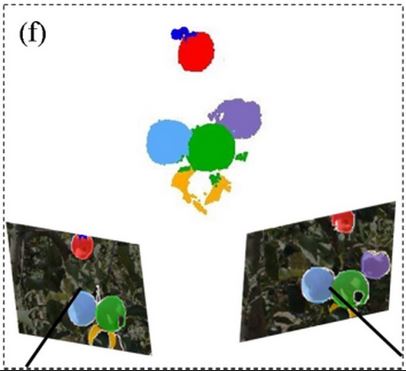New scientific article published: "Fruit detection and 3D location using instance segmentation neural networks and structure-from-motion photogrammetry"
Download PdfJordi Gené-Mola et al. have published a new article in Computers and Electronics in Agriculture. The research is related to the PAgFRUIT Project. The main highlights are: a) A dataset for 3D apple location using Structure-from-Motion (SfM) is presented, b) The proposed fruit detection algorithm combines 2D instance segmentation and SfM, c) Mask R-CNN detections were projected onto 3D point clouds based on SfM, d) Fruit detection results in 2D images reported an F1-score of 0.82 and e) Fruit location results in 3D point clouds reported an F1-score of 0.88.
Authors: Gené-Mola, J.; Sanz-Cortiella, R., Rosell-Polo, J.R., Morros, J.R, Ruiz-Hidalgo, J., Vilaplana, V., Gregorio, E., 2020. Fruit detection and 3D location using instance segmentation neural networks and structure-from-motion photogrammetry. Computers and Electronics in Agriculture 169, 105165. https://doi.org/10.1016/j.compag.2019.105165
Abstract: The development of remote fruit detection systems able to identify and 3D locate fruits provides opportunities to improve the efficiency of agriculture management. Most of the current fruit detection systems are based on 2D image analysis. Although the use of 3D sensors is emerging, precise 3D fruit location is still a pending issue. This work presents a new methodology for fruit detection and 3D location consisting of: (1) 2D fruit detection and segmentation using Mask R-CNN instance segmentation neural network; (2) 3D point cloud generation of detected apples using structure-from-motion (SfM) photogrammetry; (3) projection of 2D image detections onto 3D space; (4) false positives removal using a trained support vector machine. This methodology was tested on 11 Fuji apple trees containing a total of 1455 apples. Results showed that, by combining instance segmentation with SfM the system performance increased from an F1-score of 0.816 (2D fruit detection) to 0.881 (3D fruit detection and location) with respect to the total amount of fruits. The main advantages of this methodology are the reduced number of false positives and the higher detection rate, while the main disadvantage is the high processing time required for SfM, which makes it presently unsuitable for real-time work. From these results, it can be concluded that the combination of instance segmentation and SfM provides high performance fruit detection with high 3D data precision. The dataset has been made publicly available and an interactive visualization of fruit detection results is accessible at http://www.grap.udl.cat/documents/photogrammetry_fruit_detection.html.
